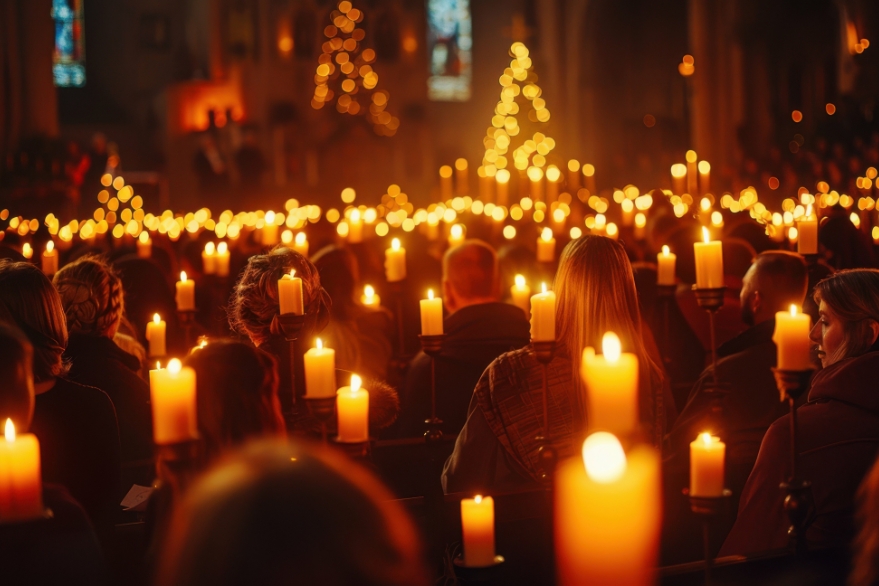Four stories behind your favourite Christmas songs and carols

As Christmas draws ever closer, many of us find ourselves listening to the same Christmas songs on repeat. But have you ever taken a moment to consider the origins of these beloved songs and the stories behind them?
Let’s take a dive into the history of some of your favourite festive tunes.
1. “Christmas (Baby Please Come Home)” by Darlene Love
This Christmas classic was originally recorded and released by Love for the album “A Christmas Gift for You from Phil Spector”, on 22nd November 1963. The song’s simple premise of a woman’s desire for her loved one to come home for Christmas made it universally relatable, from a wife anticipating her husband’s return from combat, to a recently separated couple missing the comforts of their ex-partner, which was a credit to its success.
However, the song didn’t see success until the 1980s – it had the ill fortune of being released on the same day as the assassination of then-President of the United States, John F. Kennedy. Out of respect for the tragedy, both the single and the album were temporarily pulled from stores. Reflecting on the nation’s sombre mood half a century later, the album’s now-controversial producer Phil Spector said, “no one was celebrating anything. There really was not a Christmas that year.”
It wasn’t until Love performed the song on David Letterman’s late-night TV show in 1986 that it became a hit, and Love continued to perform the song on the show year after year. In 2015, the song had its all time peak and broke into Billboard’s Top 20. The song has since been covered by the likes of U2, Mariah Carey, Cher, and Michael Bublé, among others.
2. “White Christmas” by Bing Crosby
According to Guinnes World Records, “White Christmas” is not only the biggest-selling Christmas song of all time, but its also estimated to be the biggest-selling track of all time, with estimated sales of over 50 million. Irving Berlin wrote the classic hit, which Bing Crosby first sang on air during the Kraft Music Hall radio show on 25th December 1941 . Released during the height of World War Two, the song resonated deeply with American soldiers spending their first Christmas away from home in the Pacific, especially in the wake of the attack on Pearl Harbor, which happened just a few weeks prior.
Continuing the theme of its importance in global conflict, the song also marked the end of the Vietnam War over thirty years later, in 1975. During the fall of Saigon, the Armed Forces Radio started to play “White Christmas” on repeat to signal the evacuation of American troops.
3. “Silent night”, composed by Franz Xaver Gruber to lyrics by Joseph Mohr
Perhaps the most ubiquitous Christmas carol ever made, “Silent Night” was written in 1816 by a young Catholic priest, Joseph Mohr, and his friend, Frans Xaver Gruber, who came up with the melody. They were from Obendorf, a small town in Austria, which faced severe hardship at the time; it was still recovering from the aftermath of the Napoleonic Wars which had ravaged Europe, compounded by a particularly bad harvest that year which caused widespread famine and deprivation. The carol, which was first performed in 1818 in Obendorf’s local church, resonates deeply with those times of struggle but also emphasised togetherness and humanity.
One hundred years later, these same themes resurfaced due to the carol’s pivotal role in the Christmas truce in 1914, during World War One. Although there have been differing accounts from that Christmas eve, most suggest that the truce began with carol singing from both the English and German trenches. One German officer in particular, Walter Kirchhoff, a tenor with the Berlin Opera, began to sing “Silent Night”, first in German, and then in English. As he sang in the silence, the British soldiers knew the carol and began to sing back. The two sides then began what’s been described as a “carol sing-off” – the German’s would sing one of their carols, and the Brits would sing one back.
The following day, on a clear and crisp Christmas morning, a miracle happened. German soldiers began slowly climbing out of their trenches, holding signs that read: “You no shoot, we no shoot”, and exclaiming “merry Christmas!”, in English to the Brits who slowly rose from their trenches in response. For the rest of the day, German and British soldiers fraternised, shaking hands and exchanging gifts of cigarettes, chocolate, buttons and hats. They sang more carols, and even played football together – a true Christmas miracle!
4. “Fairytale of New York” by The Pogues With Kirsty MacColl
Perhaps the most unconventional Christmas song out there, the 1987 hit single “Fairytale of New York” tells the story of an Irish immigrant spending Christmas Eve in a New York City drunk tank, reflecting on past hopes and dreams with a sense of regret and nostalgia.
It took two years to create, initially conceived as a duet between Shane MacGowan and Cait O’Riordan. However, following O’Riordan’s departure from the band, Kirsty MacColl took over the female part, which worked out for the best – her vocals fit perfectly with the slew of insults she delivers throughout the song. Interestingly, vocal parts were recorded independently, resulting in a “crackling exchange” between the two singers, who never actually met during the recording process.
Through a duet between the male protagonist and his estranged lover, the song portrays a raw, gritty reality of life’s struggles and despite —or perhaps because of— its controversial elements, the song has remained a seasonal favorite, frequently returning to the charts and being covered by various artists.

Bonus carol: The Twelve Days of Christmas
Written in the 18th century, this song actually originated as a memory game for Christian children to help them learn the tenants of their faith. Some interpretations suggest the song’s gifts have hidden meanings, such as the “true love” being a metaphor for God and the “partridge in a pear tree” symbolising Jesus Christ.
Bonus song: “Driving Home for Christmas” by Chris Rea
Rock and blues legend Chris Rea actually wrote this Christmas classic while being driven home for Christmas by his wife. Rea recounted the story to the Guardian in 2016, “We kept getting stuck in traffic…I’d look across at the other drivers, who all looked so miserable. Jokingly, I started singing: ‘We’re driving home for Christmas…’ Then, whenever the street lights shone inside the car, I started writing down lyrics.”
Unbeknownst to him at the time, the song would eventually enter the Christmas top 40 year after year, earning him a whopping £200,000 on average every December!
So, next time you put your Christmas playlist on, think about the rich histories and personal stories behind each song. Whether it’s the wartime memories of “White Christmas,” the miraculous truce inspired by “Silent Night,” or the gritty realism of “Fairytale of New York,” these songs offer more than just festive cheer—they connect us to moments in history and shared human experience. Happy listening and Merry Christmas!
Stuck for inspiration? Why don’t you check out our Spotify playlist!

Don’t forget our branches are hosting a range of festive activities leading up to the big day, so get in touch with your local branch to get involved!
Sources:
Financial Times
CBS News
The Washington Post
The Guardian
This is a marketing blog by Howden.



